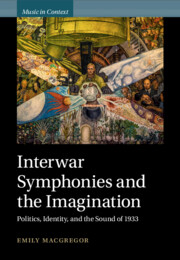18 results
3 - Liberalism, Race, and the American West in Roy Harris’s Symphony 1933
-
- Book:
- Interwar Symphonies and the Imagination
- Published online:
- 28 January 2023
- Print publication:
- 26 January 2023, pp 83-113
-
- Chapter
- Export citation
Dedication
-
- Book:
- Interwar Symphonies and the Imagination
- Published online:
- 28 January 2023
- Print publication:
- 26 January 2023, pp v-vi
-
- Chapter
- Export citation
Figures
-
- Book:
- Interwar Symphonies and the Imagination
- Published online:
- 28 January 2023
- Print publication:
- 26 January 2023, pp viii-viii
-
- Chapter
- Export citation
Acknowledgements
-
- Book:
- Interwar Symphonies and the Imagination
- Published online:
- 28 January 2023
- Print publication:
- 26 January 2023, pp xii-xiv
-
- Chapter
- Export citation
4 - Aaron Copland’s and Carlos Chávez’s Pan-American Bounding Line
-
- Book:
- Interwar Symphonies and the Imagination
- Published online:
- 28 January 2023
- Print publication:
- 26 January 2023, pp 114-168
-
- Chapter
- Export citation
2 - Listening for the Intimsphäre in Hans Pfitzner’s Symphony in C♯ Minor
-
- Book:
- Interwar Symphonies and the Imagination
- Published online:
- 28 January 2023
- Print publication:
- 26 January 2023, pp 45-82
-
- Chapter
- Export citation
5 - Arthur Honegger’s ‘Modernised Eroica’
-
- Book:
- Interwar Symphonies and the Imagination
- Published online:
- 28 January 2023
- Print publication:
- 26 January 2023, pp 169-205
-
- Chapter
- Export citation
Select Bibliography
-
- Book:
- Interwar Symphonies and the Imagination
- Published online:
- 28 January 2023
- Print publication:
- 26 January 2023, pp 236-252
-
- Chapter
- Export citation
1 - Between Europe and America: Kurt Weill’s Symphony in a Suitcase
-
- Book:
- Interwar Symphonies and the Imagination
- Published online:
- 28 January 2023
- Print publication:
- 26 January 2023, pp 1-44
-
- Chapter
- Export citation

Interwar Symphonies and the Imagination
- Politics, Identity, and the Sound of 1933
-
- Published online:
- 28 January 2023
- Print publication:
- 26 January 2023
6 - The Right Kind of Symphonist: Florence Price and Kurt Weill
-
- Book:
- Interwar Symphonies and the Imagination
- Published online:
- 28 January 2023
- Print publication:
- 26 January 2023, pp 206-235
-
- Chapter
- Export citation
Copyright page
-
- Book:
- Interwar Symphonies and the Imagination
- Published online:
- 28 January 2023
- Print publication:
- 26 January 2023, pp iv-iv
-
- Chapter
- Export citation
Preface
-
- Book:
- Interwar Symphonies and the Imagination
- Published online:
- 28 January 2023
- Print publication:
- 26 January 2023, pp xi-xi
-
- Chapter
- Export citation
Contents
-
- Book:
- Interwar Symphonies and the Imagination
- Published online:
- 28 January 2023
- Print publication:
- 26 January 2023, pp vii-vii
-
- Chapter
- Export citation
Index
-
- Book:
- Interwar Symphonies and the Imagination
- Published online:
- 28 January 2023
- Print publication:
- 26 January 2023, pp 253-270
-
- Chapter
- Export citation
Abbreviations
-
- Book:
- Interwar Symphonies and the Imagination
- Published online:
- 28 January 2023
- Print publication:
- 26 January 2023, pp xv-xvi
-
- Chapter
- Export citation
Examples
-
- Book:
- Interwar Symphonies and the Imagination
- Published online:
- 28 January 2023
- Print publication:
- 26 January 2023, pp ix-x
-
- Chapter
- Export citation
Laura Tunbridge, Singing in the Age of Anxiety: Lieder Performances in New York and London Between the Wars (Chicago: University of Chicago Press, 2018), ISBN 978-0-226-56357-2 (pb).
-
- Journal:
- Twentieth-Century Music / Volume 17 / Issue 2 / June 2020
- Published online by Cambridge University Press:
- 17 April 2020, pp. 277-282
-
- Article
- Export citation



